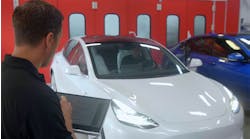Let’s start with a quick story. (It’s true, but the way, even though I’ll refrain from mentioning any names.)
A customer takes a high-end vehicle into a collision repair facility. The customer says that, since the time of their recent accident the vehicle’s navigation system no longer works. No problem, right? Well, there was a problem. I mean, my friend’s shop had the right diagnostic scan tool to check on that system. His team hooked it up, and pulled the data. But the vehicle said the navigation gave out seven months and 8,000 miles earlier. The issue wasn’t related to the accident.
As is often the case with repairs, the shop shared its findings with the insurance carrier. The carrier denied the claim for the navigation system (after all, it didn’t pertain to the accident).
The customer sued the shop. He said it was his data, and the shop had no right to share it with a third party.
Was that customer right? Maybe ...
My friends, you have heard a lot about diagnostic scanning in the last year. The topic is everywhere, as it should be. It’s a critical issue. But one aspect that we haven’t discussed is the actual data that is transmitted—and who owns that data.
This isn’t cut and dry; there’s no clear answer. And that’s where problems occur.
To better understand it, let’s quickly discuss how we got to this place. We hear about self-driving cars in mainstream media on a regular basis, but the true focus for OEMs is in four key areas: improved fuel economy, enhanced “comfort” features, minimizing injuries, and preventing deaths.
"There must be language that clearly states that the vehicle owner gives you full permission to ... share that data with a third party"
—Mike Anderson, Owner, Collision Advice
The last one is clearly the big one. The World Health Organization predicted that, if no measures are put in place to impede the trend, fatalities due to vehicle accidents will become the fifth-leading cause of death worldwide by 2030. Well, depending on the numbers you check, many had it already at No. 4 by the end of 2016. According to the National Safety Council, traffic deaths increased 6 percent and topped 40,000 total fatalities for the first time since 2007.
By their very nature, accidents are unintentional, so automakers have been tasked with finding solutions to help drivers operate their vehicles in a safe manner. Enter technology. Modern vehicles have more than 100 million lines of code in them, more than twice as many as a Boeing 787 and F-35 fighter—combined. The Large Hadron Collider (the world’s largest and most powerful particle accelerator) only has 50 million lines of code.
Bottom line: Today’s vehicles are complex. That’s why I am such a proponent and advocate for pre- and post-repair diagnostic scanning. I’ve been over it a number of times (even in print, in this space), so I won’t repeat myself here. Let’s skip that step and assume that you now do scan vehicles and make repair decisions based off that data. Well, that data adds another element to the process, doesn’t it?
No one wants to be sued for following through on a repair in the proper way. No one. And no one should get sued for this. That story I told in opening this column didn’t need to take place. There’s a simple solution that everyone can (and should) add to their process to prevent it: authorization.
We all are using an authorization form for our repair work, right? (The answer needs to be yes, by the way.) Well, we need to have separate and distinct language for scanning and the data that comes out of it.
There are some examples of very strong authorization forms out there in the industry right now. (CDS, maker of the asTech2 device, actually has a great one on the company’s website.) Take a look and utilize that language in the forms you have your customers sign. The most important aspect: There must be language that clearly states that the vehicle owner gives you full permission to scan the vehicle and share that data with a third party. That covers your bases when you need to submit the claim, whether it’s for a warranty claim or insurance claim.
It can really be that simple in preventing a potentially combative situation with a customer. Our industry is complex enough these days without having to worry about litigation as a result of doing the right thing. I don’t want to hear these horror stories. I don’t want to have to relay them to you. Protect yourself. Protect your processes. Protect the customer. That’s what we’re here to do.



